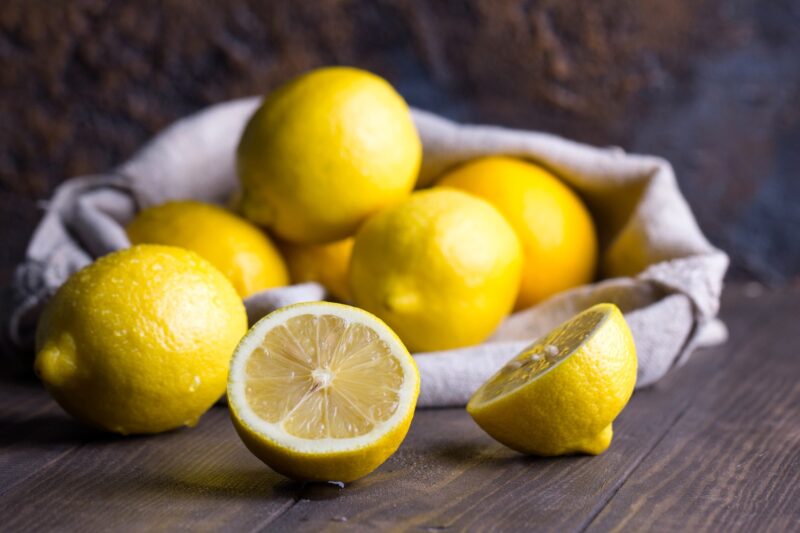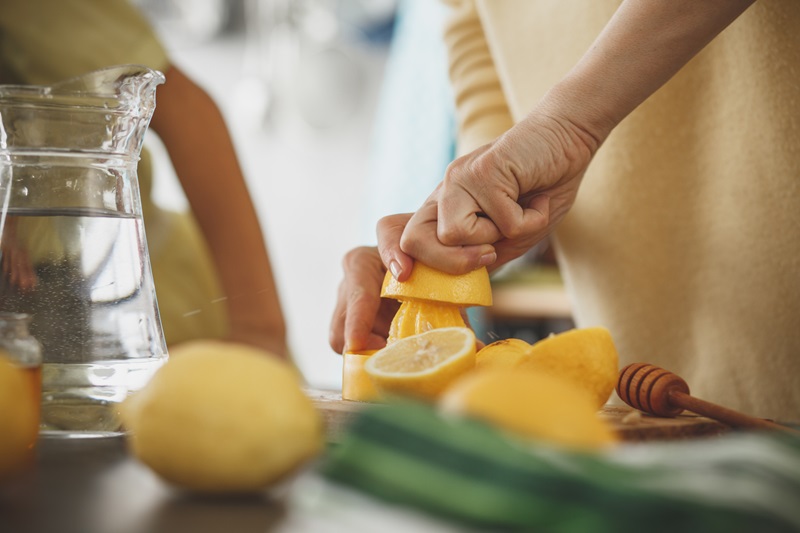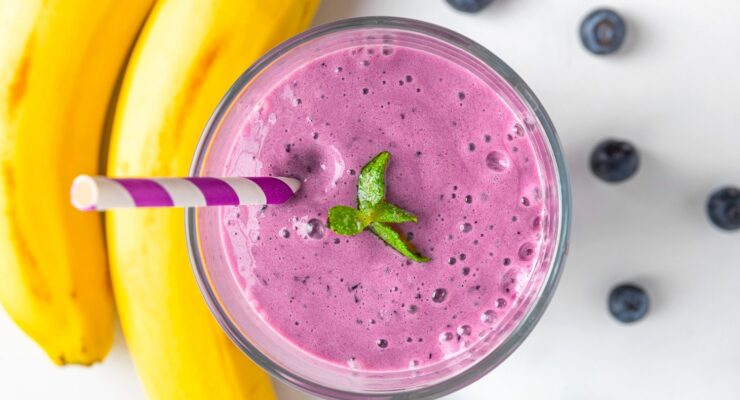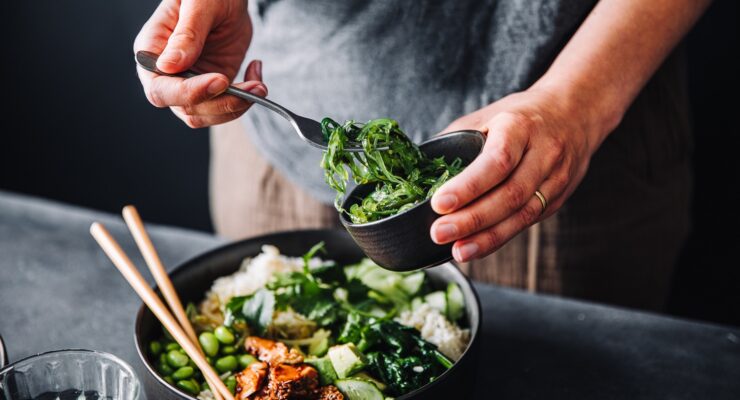Superfood Spotlight: The Health Benefits of Lemons
Article posted in: Diet & Nutrition
Lemons are more than just a simple garnish for your beverages or a dessert flavor enhancer—they’re bona fide superfoods. Packed with essential nutrients, lemons offer numerous health benefits. Their zesty flavor not only enhances a variety of dishes—from beverages to main courses to desserts—but does so without adding unnecessary calories. Discover how lemons can be a vital component of a healthy diet below.
Lemon Nutrition and Caloric Content

Low-Calorie Powerhouse: Nutritional Breakdown of Lemons
An average whole lemon comes with about 17 calories and has 0 grams of fat and just 5 total grams of carbohydrates, according to the United States Department of Agriculture (USDA).
Nutrisystem classifies lemons and lemon juice as Free Foods because they are so low in calories, fats and carbs. That means you can enjoy as much of them as you like and stay on track with your weight loss plan.
Vitamin C and Potassium Levels in Lemons
Lemons are a concentrated source of essential vitamins and minerals. You get 51 percent of your recommended daily allowance of vitamin C, a crucial nutrient for the immune system, from the juice of one lemon. It also has 80 milligrams of potassium, which plays a key role in managing metabolism and blood pressure.
Historical Uses of Lemons: From Ancient Times to Today

Origin and Cultivation: Tracing Lemon’s Lineage
Lemons as we know them are a hybrid of a fruit known as a “citron” crossed with sour oranges. Citrons are similar to lemons in color and shape, but they are bigger than lemons, have slightly rougher skin, and are less juicy with drier pulp.
Citron trees were widely grown in the Middle East in the era of the Roman Empire for their ornamental appeal and their fragrance when in bloom, but typically not for eating. Citrons can still be found in specialty stores, especially those specializing in Indian and other South Asian cuisines, which prize the less acidic flavor for a variety of recipes.
Lemons on the High Seas: Preventing Scurvy Among Sailors
Christopher Columbus and other Spanish explorers of North America brought seeds and trees to California and Florida. By the 1700s, lemons were included in the rations for British sailors on long voyages because the fruit’s juice helped to prevent scurvy, a vitamin C deficiency that can lead to weakness, fatigue, bleeding gums and bruising.
Today, Americans consume about 4.7 pounds of lemons per capita each year, according to The Packer, a produce industry journal. California, Florida and Arizona are the leading producers of lemons in the U.S., while Mexico is the world’s top grower of the fruit. Lemons are valued across the globe today for their juice and zest. The fruit is used fresh, grilled, preserved or pickled.
Comprehensive Guide to Lemon Health Benefits

Lemons are high in powerful micronutrients known as flavonoids. Extensive research has linked lemons to a wide range of health benefits.
Boosting Heart Health with Citrus Flavonoids
Citrus flavonoids “possess vascular protection, anti-hypertension, and anti-atherosclerosis effects,” according to a survey of the research, published in the journal Frontiers in Nutrition. That means including lemons in your diet may reduce the risk of heart disease and high blood pressure.
Diabetes Management: Lemons and Blood Sugar Regulation
The flavonoids also work to regulate the blood glucose levels in people with diabetes, the Frontiers in Nutrition report says.
Cancer Prevention Potential of Citrus Pectin
Pectin is a kind of fiber found in many kinds of fruit. Citrus pectin is abundant in lemon peels and pulp. Consuming it has been linked to decreased risk of colon and prostate cancers, the Frontiers in Nutrition article states.
Benefits of Lemons for Skin Health
Lemon polyphenols also protected skin cells from damage caused by sunlight in a lab study, with the results published in another edition of Frontiers in Nutrition. Some people report having success treating acne with lemon juice, but there is no credible research that confirms it works.
Preventing Kidney Stones with Lemon Juice
Citrate, a kind of salt in lemon juice, binds to calcium in your kidneys, which is the mineral that forms the stones. Drinking a half-cup of lemon juice concentrate diluted in water each day may reduce your risk, says a report from Harvard Health.
Culinary Delights: Cooking and Baking with Lemons

Refreshing Lemon Water and Healthy Lemonade Options
The simplest way to enjoy the health benefits of lemons is to add a few slices to water. Hot water with lemon is a warm, soothing drink that you can enjoy any time of day. Lemon slices make cool tap water or seltzer even more refreshing. If you prefer a glass of lemonade, try this healthier version that’s approved by the dietitians at Nutrisystem!
Using Lemons in Marinades for Enhanced Flavor
In marinades, the citric acid in lemons helps to tenderize meat and fish while infusing the food with flavor. Our simple Lemon Thyme Vinaigrette recipe works as both a marinade and light and tasty salad dressing.
The Art of Preserving Lemons
Preserved lemons are popular in Mediterranean and North African cuisines. To make them, the fruit may be set in barrels of salt or jars of brine (salt water), then allowed to slowly cure as the sodium penetrates the outer rind. Over time the lemon’s sharply tart flavor mellows, while maintaining their citrusy taste.
Preserved lemons are best known for their use in tagine, a one-pot stew popular in Morocco. They also bring rich flavor to pasta, risotto and other rice dishes, grilled fish or chicken, and cooked vegetables.
Fresh or preserved lemons are the flavor booster in this One-Pan Skillet Lemon Chicken with Rice. It’s a complete meal, featuring tender chicken breast, mild-tasting zucchini and high-fiber brown rice. Lemons bring the spark of flavor that ties it all together.
Creative Ways to Use Lemon Zest in Your Recipes
Many of a lemon’s most potent nutrients are in the outer rind. The zest, or the grated rind, also is loaded with flavorful oils that sparkle in baked goods and other desserts, cocktails and sauces.
We love it in homemade Lemon Zest Ricotta Cream. It’s rich in protein and delicious eaten with a spoon like yogurt, spread on toast like cottage cheese, or as a dip for fresh fruit like strawberries.
You can also enjoy lemon zest in our recipes for Lemon Lavender Scones, Lemon Ricotta Pasta and Mini Lemon Bundt Cakes.
Light and Flavorful Lemon Desserts
The most delightful way to soak up the benefits of this superfood just might be our Lightened-Up Lemon Bars. They have the rich, creamy texture and sweet-tart flavor you love, but less calories and fat than standard lemon bars. Your whole family will cheer for them!
Looking for more sweet, lemony treats? Try our healthy recipes for Iced Lemon Loaf Cake, Lemon Meringue Pie and Strawberry Lemon Icebox Cake.
Tips for Selecting and Preserving Fresh Lemons

Choosing the Best Lemons at the Market
These days, lemons are available year-round in most supermarkets. You can also find lemon juice fresh, frozen and in concentrate.
Eureka is the most widely sold lemon variety, but you may find others. Meyer lemons are smaller and sweeter, and not often found in stores. However, they grow on petite trees that can fit into a large pot, so many people have them on their patios in the summer or inside their homes.
When buying lemons, go for fruit that is heavy compared to others, which means it is fresh and juicy. The skin should be bright yellow with no wrinkling or puckering. The fruit should be firm but not rock-hard and be free of soft spots. A ripe lemon will have a fresh, light scent.
Proper Storage Techniques for Lemons
Lemons will keep for a week or more on your counter and will give your house a pleasant fragrance. If they’re sitting out, be sure to put them away from direct sunlight.
For longer storage, place them in the crisper drawer of your refrigerator, where they will stay ready to eat for about three weeks. Make sure they stay away from moisture and avoid washing them until you are ready to use them to prevent mold from forming on the rind.






